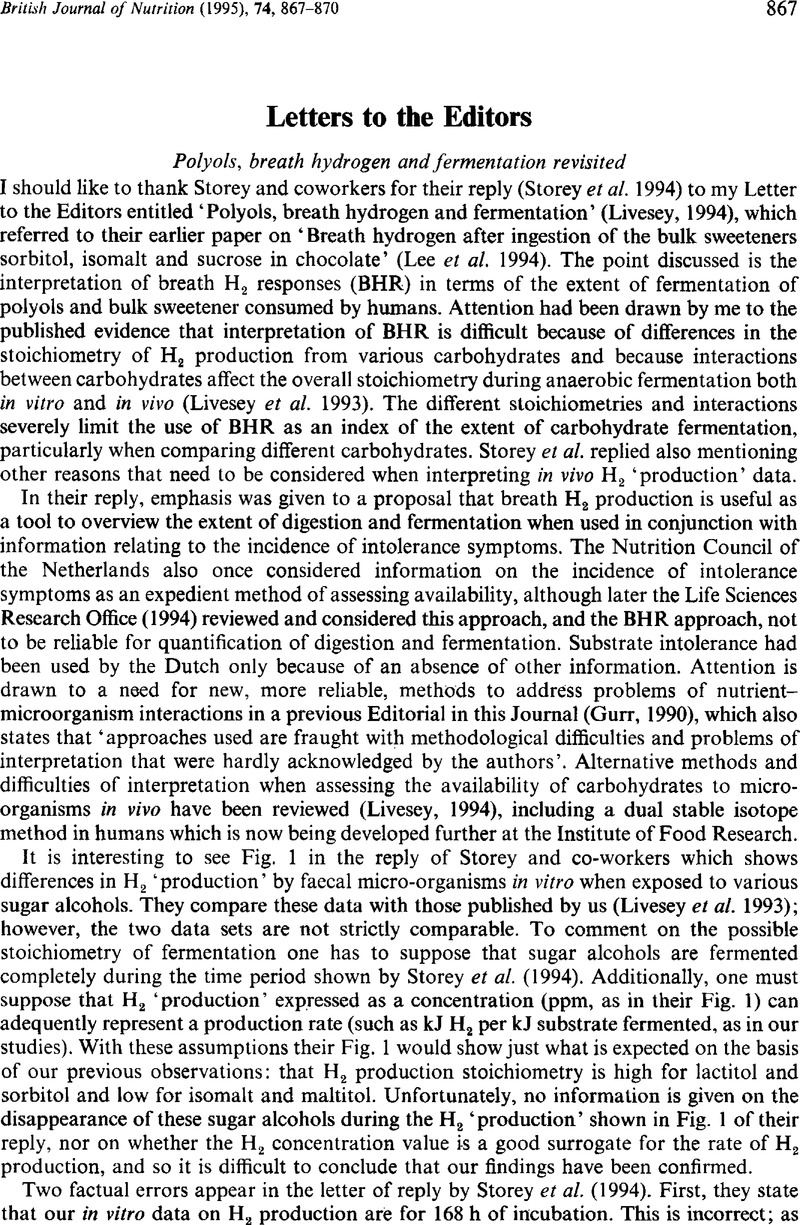Crossref Citations
This article has been cited by the following publications. This list is generated based on data provided by Crossref.
Champ, M.
and
Faisant, N.
1996.
Carbohydrates as Organic Raw Materials III.
p.
189.
Champ, M. M. -J.
1996.
The analysis of complex carbohydrates: relevance of values obtained in vitro.
Proceedings of the Nutrition Society,
Vol. 55,
Issue. 3,
p.
863.
Asp, N.-G
van Amelsvoort, J. M. M.
and
Hautvast, J. G. A. J.
1996.
Nutritional Implications Of Resistant Starch.
Nutrition Research Reviews,
Vol. 9,
Issue. 1,
p.
1.
Noah, Lionel
Robert, Paul
Millar, Samuel
and
Champ, Martine
1997.
Near-Infrared Spectroscopy As Applied to Starch Analysis of Digestive Contents.
Journal of Agricultural and Food Chemistry,
Vol. 45,
Issue. 7,
p.
2593.
Oates, Christopher G.
1997.
Towards an understanding of starch granule structure and hydrolysis.
Trends in Food Science & Technology,
Vol. 8,
Issue. 11,
p.
375.
Plaami, Sirkka P.
1997.
Content of dietary fiber in foods and its physiological effects.
Food Reviews International,
Vol. 13,
Issue. 1,
p.
29.
Lebet, V.
Arrigoni, E.
and
Amado, R.
1998.
Digestion Procedure Using Mammalian Enzymes to Obtain Substrates for Fermentation Studies.
LWT - Food Science and Technology,
Vol. 31,
Issue. 6,
p.
509.
Brighenti, Furio
Casiraghi, M. Cristina
and
Baggio, Cristina
1998.
Resistant starch in the Italian diet.
British Journal of Nutrition,
Vol. 80,
Issue. 4,
p.
333.
Noah, Lionel
Guillon, Fabienne
Bouchet, Brigitte
Buléon, Alain
Molis, Christine
Gratas, Maria
and
Champ, Martine
1998.
Digestion of Carbohydrate from White Beans (Phaseolus vulgaris L.) in Healthy Humans.
The Journal of Nutrition,
Vol. 128,
Issue. 6,
p.
977.
Bello-Pérez, Luis A.
Agama-Acevedo, Edith
Sánchez-Hernández, Laura
and
Paredes-López, Octavio
1999.
Isolation and Partial Characterization of Banana Starches.
Journal of Agricultural and Food Chemistry,
Vol. 47,
Issue. 3,
p.
854.
Champ, Martine
Kozlowski, Françoise
and
Lecannu, Gérard
2000.
Advanced Dietary Fibre Technology.
p.
106.
Bello-Pérez, Luis Arturo
Agama-Acevedo, Edith
Sáyago-Ayerdi, Sonia G.
Moreno-Damian, Esther
and
Figueroa, J. D. C.
2000.
Some Structural, Physicochemical and Functional Studies of Banana Starches Isolated from two Varieties Growing in Guerrero, México.
Starch - Stärke,
Vol. 52,
Issue. 2-3,
p.
68.
Silva, Carlos P
Terra, Walter R
Xavier-Filho, José
Grossi de Sá, Maria F
Isejima, Eliza M
DaMatta, Renato A
Miguens, Flávio C
and
Bifano, Thais D
2001.
Digestion of legume starch granules by larvae of Zabrotes subfasciatus (Coleoptera: Bruchidae) and the induction of α–amylases in response to different diets.
Insect Biochemistry and Molecular Biology,
Vol. 31,
Issue. 1,
p.
41.
Rabbani, Golam H.
Teka, Telahun
Zaman, Badiuz
Majid, N.
Khatun, Makhduma
and
Fuchs, George J.
2001.
Clinical studies in persistent diarrhea: Dietary management with green banana or pectin in Bangladeshi children.
Gastroenterology,
Vol. 121,
Issue. 3,
p.
554.
Langkilde, Anna Maria
Champ, Martine
and
Andersson, Henrik
2002.
Effects of high-resistant-starch banana flour (RS2) on in vitro fermentation and the small-bowel excretion of energy, nutrients, and sterols: an ileostomy study.
The American Journal of Clinical Nutrition,
Vol. 75,
Issue. 1,
p.
104.
Liljeberg Elmståhl, H
2002.
Resistant starch content in a selection of starchy foods on the Swedish market.
European Journal of Clinical Nutrition,
Vol. 56,
Issue. 6,
p.
500.
Champ, Martine
Langkilde, Anna-Maria
Brouns, Fred
Kettlitz, Bernd
and
Bail-Collet, Yves Le
2003.
Advances in dietary fibre characterisation. 2. Consumption, chemistry, physiology and measurement of resistant starch; implications for health and food labelling.
Nutrition Research Reviews,
Vol. 16,
Issue. 2,
p.
143.
BELLO-P�REZ, LUIS A.
S�YAGO-AYERDI, SONIA G.
M�NDEZ-MONTEALVO, GUADALUPE
and
TOVAR, JUSCELINO
2004.
In Vitro Digestibility of Banana Starch Cookies.
Plant Foods for Human Nutrition,
Vol. 59,
Issue. 2,
p.
79.
Champ, M.
2004.
Starch in Food.
p.
560.
Millan-Testa, C. E.
Mendez-Montealvo, M. G.
Ottenhof, M.-A.
Farhat, I. A.
and
Bello-Pérez, L. A.
2005.
Determination of the Molecular and Structural Characteristics of Okenia, Mango, and Banana Starches.
Journal of Agricultural and Food Chemistry,
Vol. 53,
Issue. 3,
p.
495.



